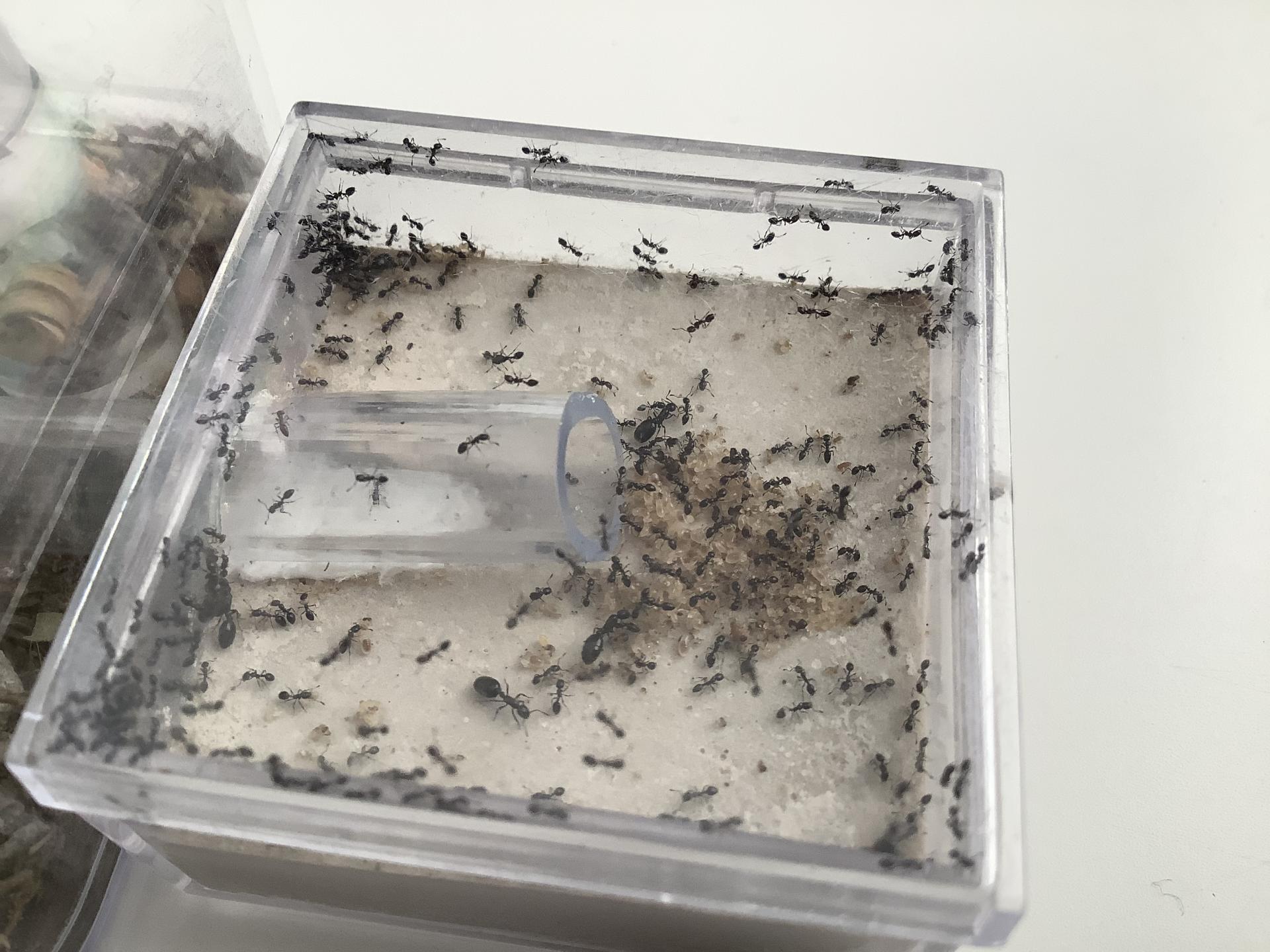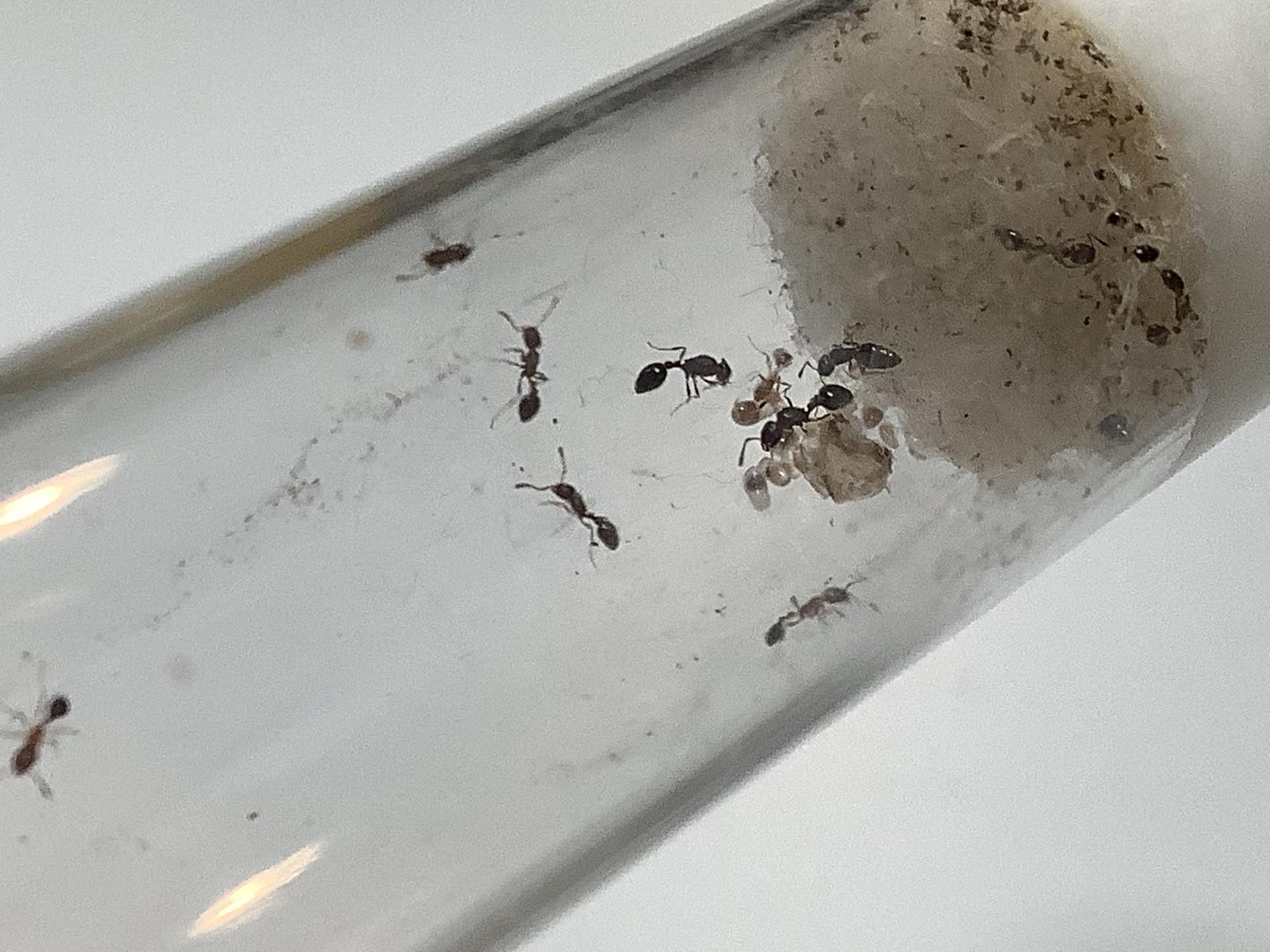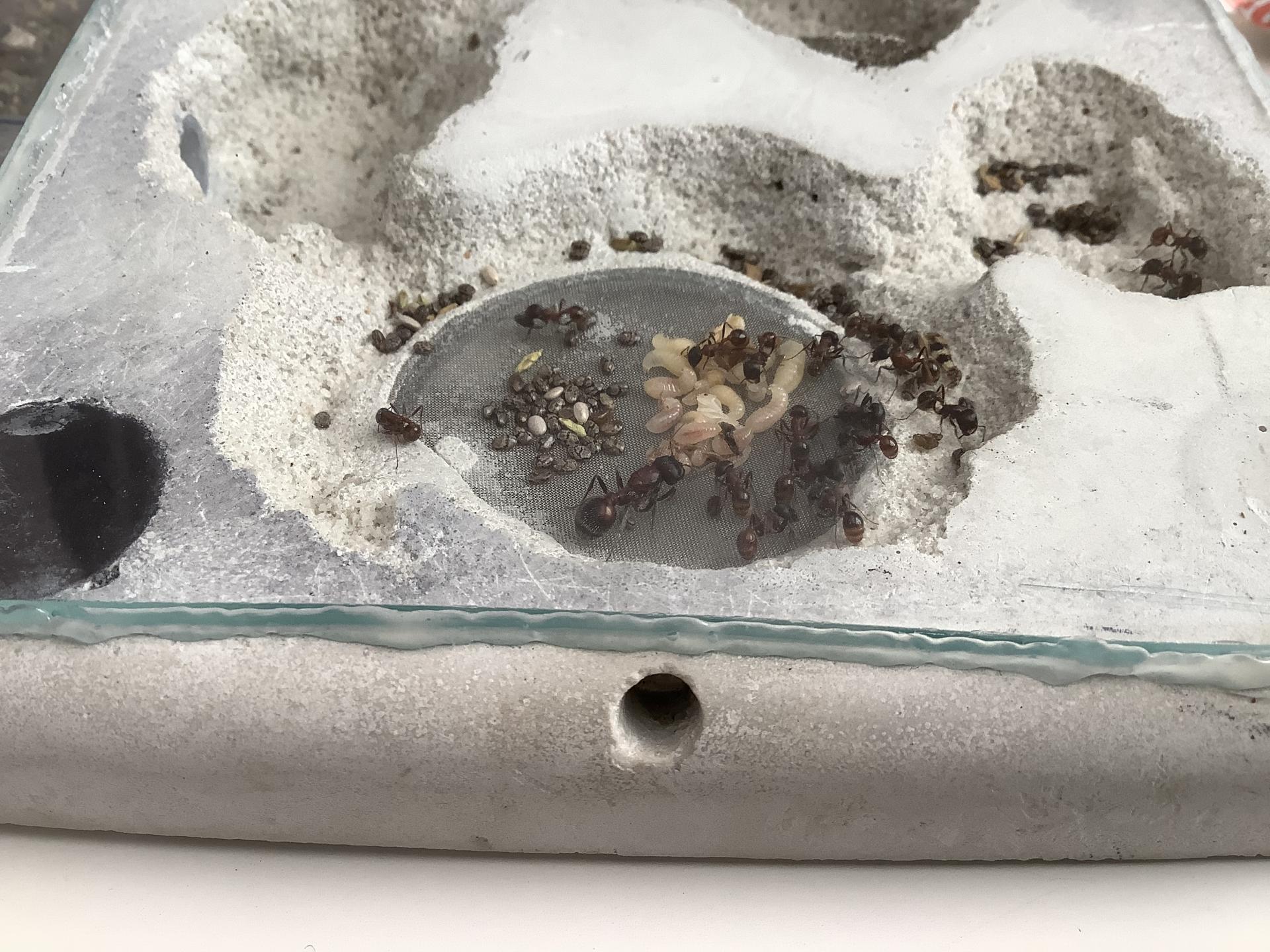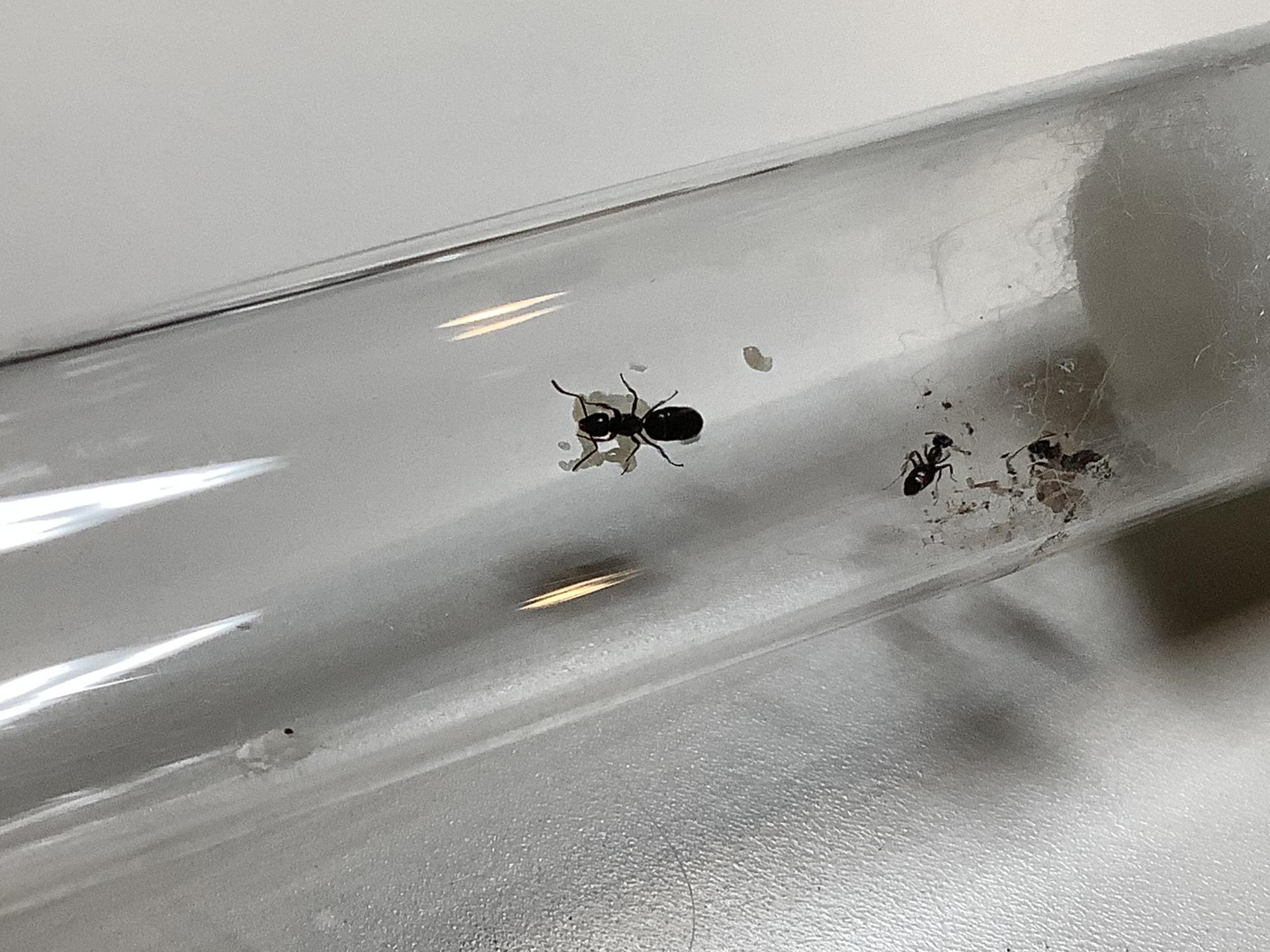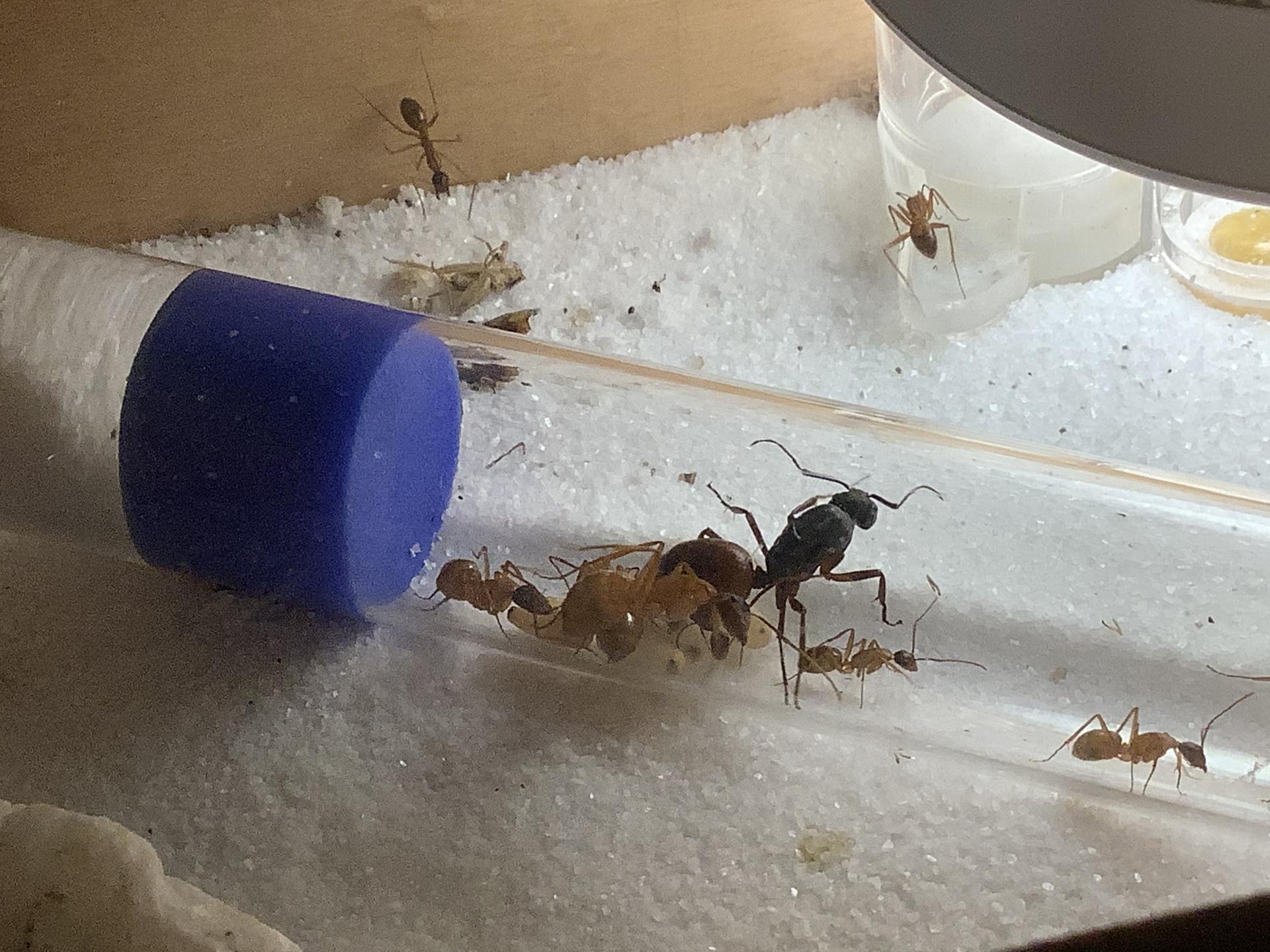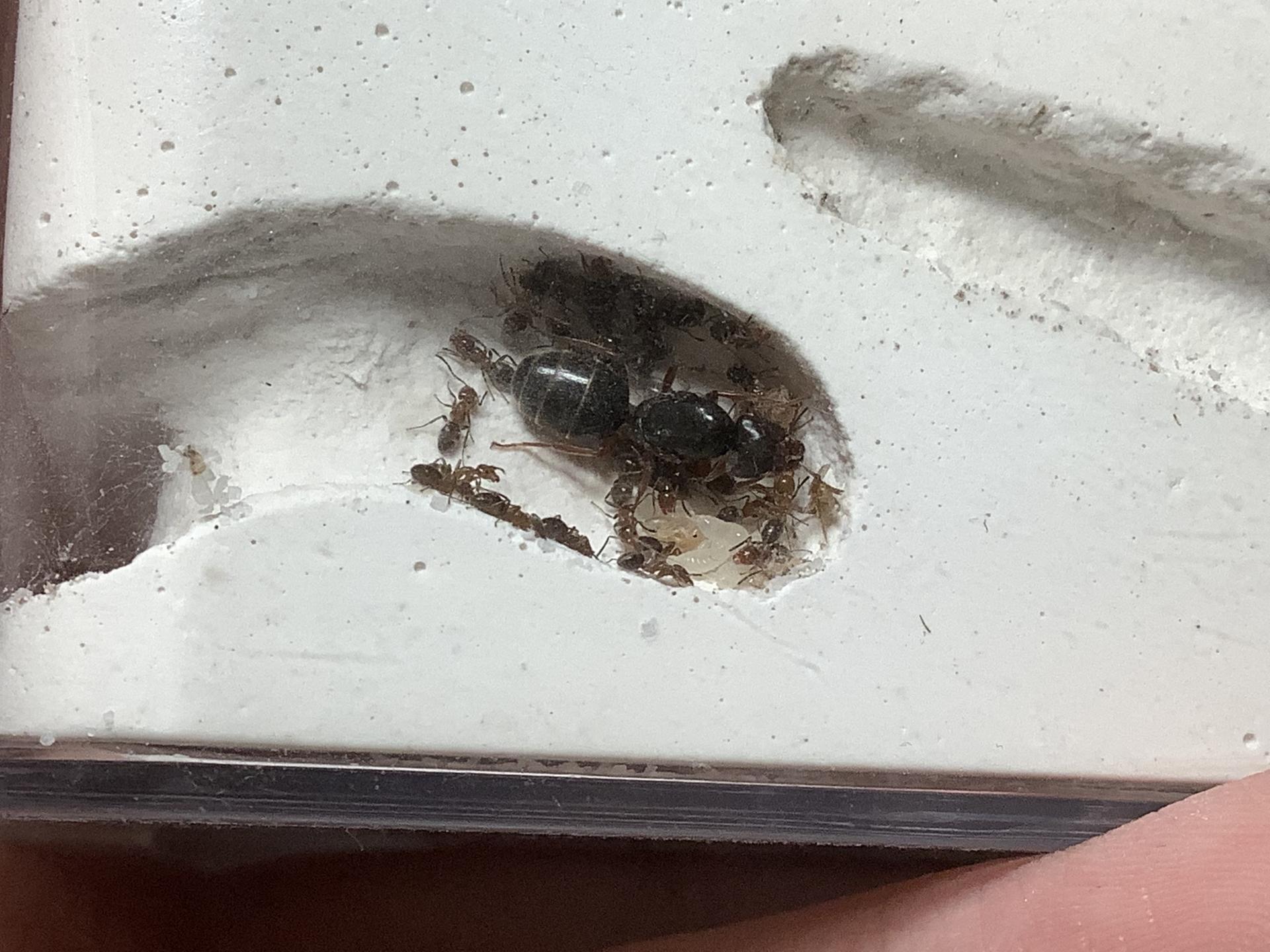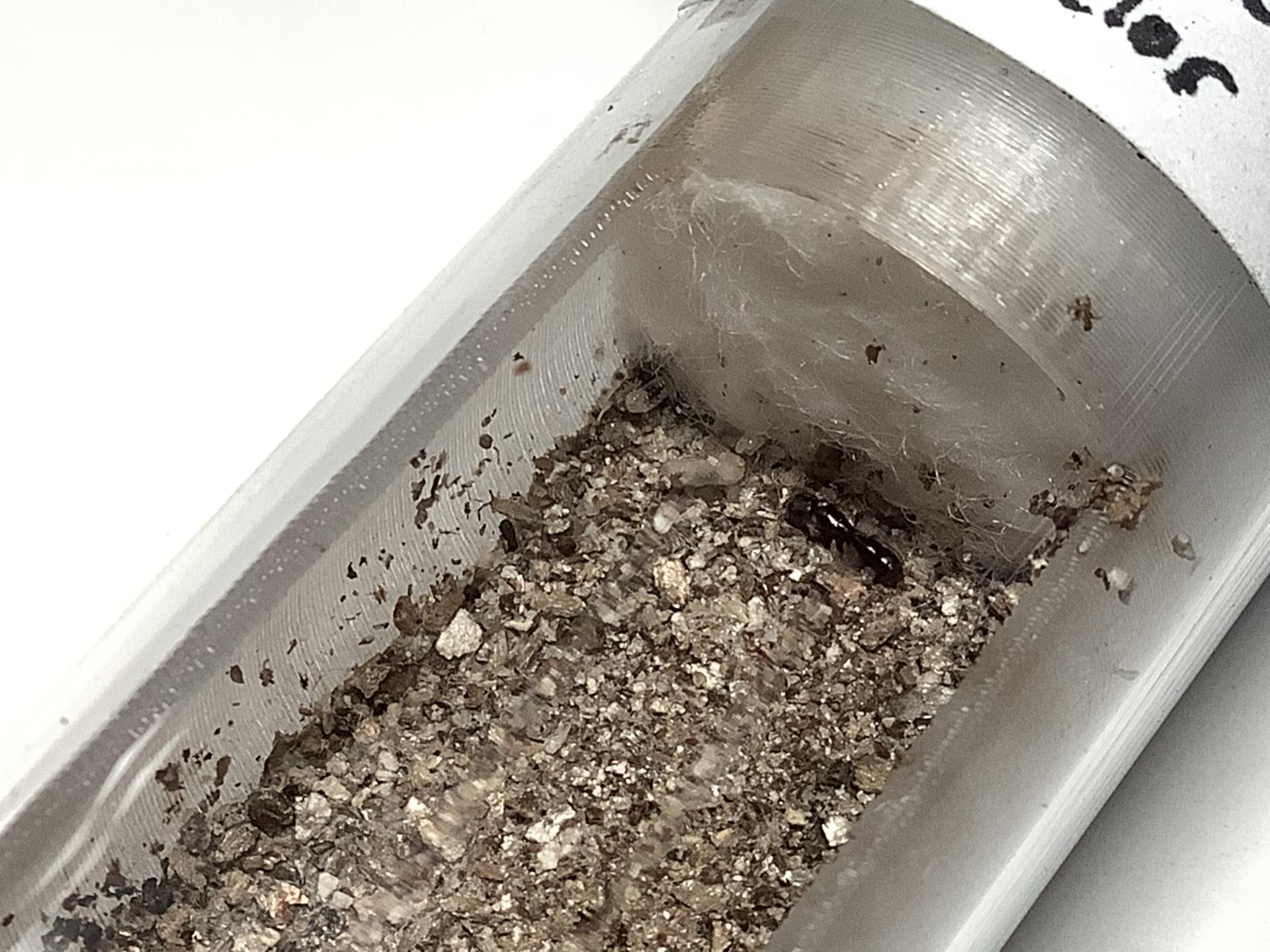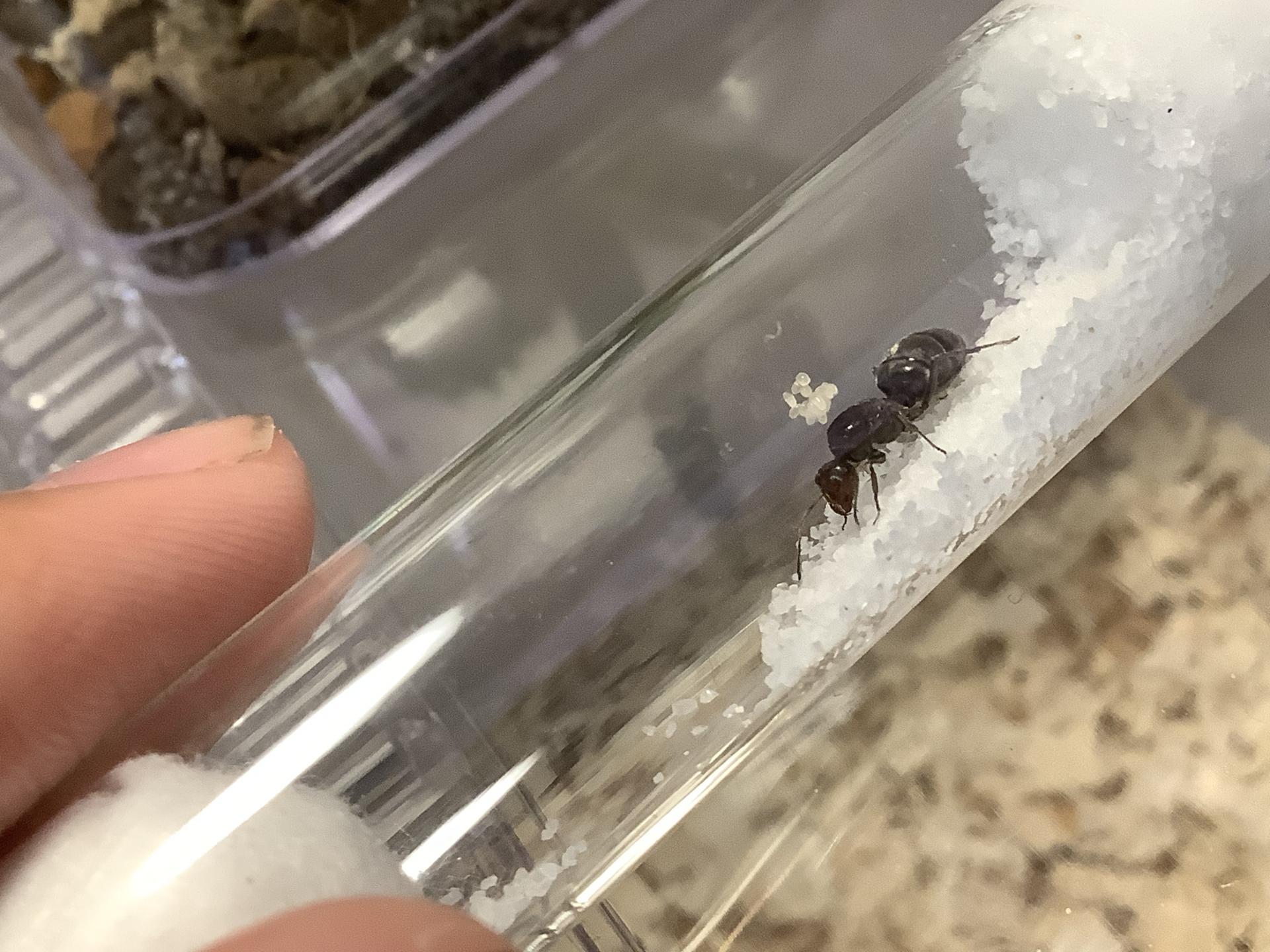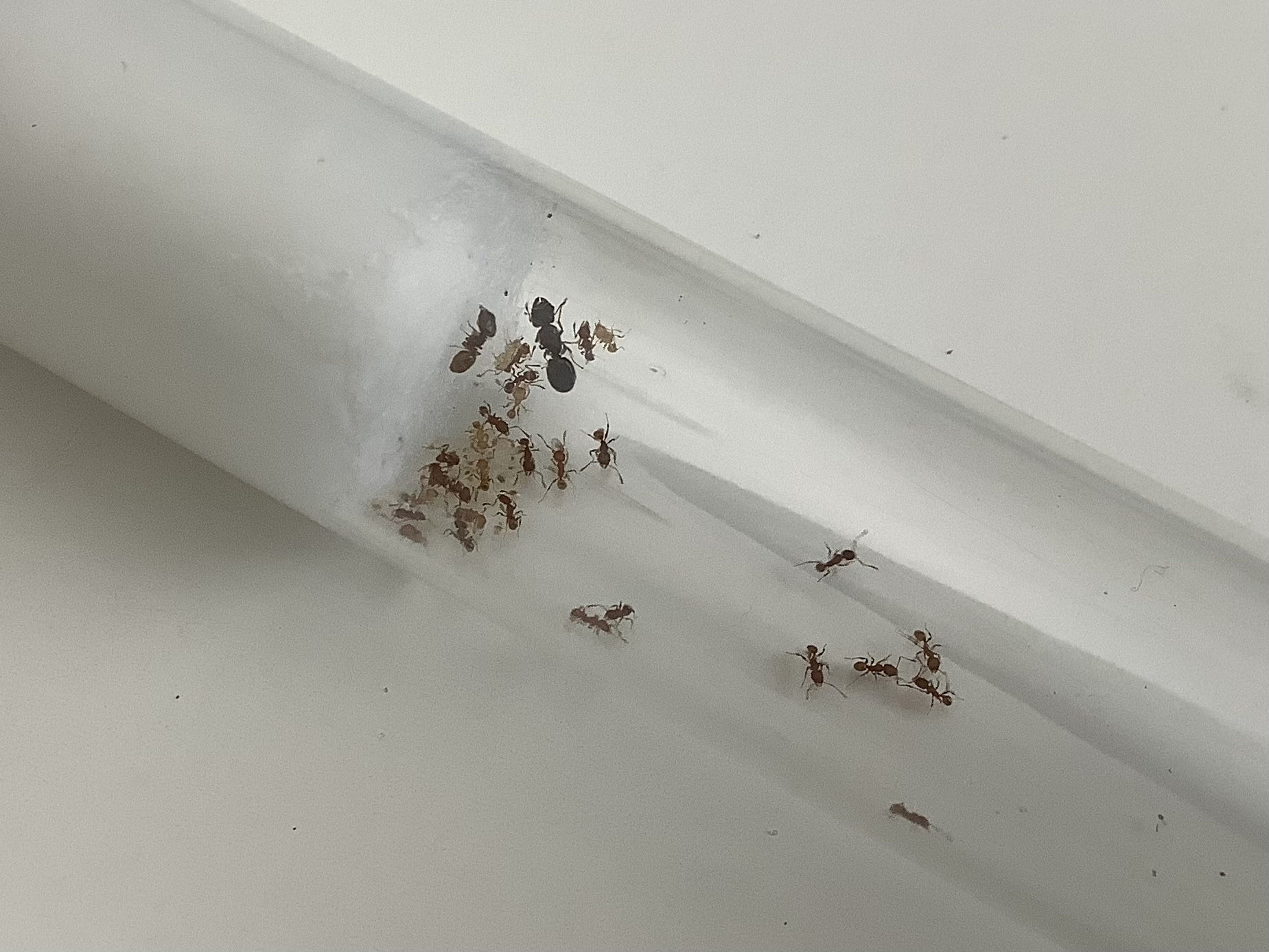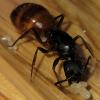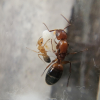UPDATEEE!!! I doubt I'll be able to update as much, since I unwisely chose some rather tough classes this year. Not sure if I can catch up with homework and deal with ants at the same time, but I'll try my best. I might add pictures later this week, so stay posted!
Cardiocondyla mauritanica: They're doing super well at the moment. Their brood pile and worker count has literally doubled in size, probably because of the colony combination that actually worked. They probably have around 15 queens and 75-100 workers. 2 of the 15 queens were actually alates born from the massive brood pile, which eventually shed their wings (possibly mated? I dunno if there are any males in there, but there are then they're probably ergatoid). They've been fed a diet of around 5-10 fruit flies daily, until they started needing more food, so I switched to a 1.5" cut-up mealworm every couple days. They also accepted fish flakes, so I left a small pile of them in their outworld. I prefer to feed my ants exclusively pink fish flakes for some reason, probably because I like watching their larvae turn pink from the inside.
Monomorium ergatogyna: My custom formicarium Monomorium ergatogyna colony has just been in some sort of diapause the whole time, probably because I either neglected to feed or water them, so they all just stayed in their nest and chilled in there. I left some food in the outworld, but they're not coming out to eat. Worker count is probably around 150-200, with about 7-8 queens. The brood pile has gotten slightly smaller, but they don't seem to be having a severe die-off. However, my 4-queen colony in a test tube did have a huge worker die-off. I originally decided to sell the colony, but then some things happened with the customer and the purchase got delayed and put off. In the meantime, I forgot to feed them and couldn't replace their dry test tube, so a fair amount of workers and a queen died. My remaining 3 queens and around 10 workers survived, so I put them into a fresh, clean test tube with some honey and a fruit fly, which they plumped up on. No eggs from them yet, but hopefully they'll recover from that soon.
Tetramorium immigrans: This colony is literally just a pain in the *ss at this point. Well over 500 workers, they destroy all the food I give them in a matter of days. No amount of mealworms or superworms will keep them satisfied, and their water tower goes empty twice a week. I'm hoping the huge pile of fish flakes I sprinkled into their formicarium will deal with them for a few days. I highly doubt anyone would want to purchase them if I decide to sell though.
Pogonomyrmex rugosus: Awesome colony, they're growing pretty quickly, with over 35 workers and a huge brood pile. They also love gorging on fish flakes, and the occasional moths and crane flies I drop in. They've made a pile of seeds in a chamber of their nest, and I sometimes catch the workers splitting the seeds open and feeding the insides to their larvae. Beautiful black and red ants, and super fun to keep...
Camponotus us-ca02: The biggest ants I've ever kept. I moved them to a small formicarium that NancyZamora made, which I got along with the Solenopsis molesta queen that I will mention later. They've remained at around the same worker count as last time, around 10-12 workers, but have a bunch of small larvae and a few pupae. They don't eat as much as my other ants for some reason, although they used to show a preference for grasshopper legs and large moths. I feed them mealworm and superworm chunks though, which they drink the fluids of but don't like nearly as much. The only thing they seem to go out into their outworld for is to drink from the water tower and occasionally take a sip of the honey puddle next to it.
Liometopum occidentale: These girls are even crazier than the Tetras. I already have over 100 workers, and the next gen will probably bring it to 200-300. There's a bunch of brood that they stuffed into one of the narrower chambers of the nest that I have them in. They love honey and sugar water, as well as actual normal water, which they swarm over. I've been feeding them mealworm slices, small moths, and fruit flies, which they all show equal preference to.
Hypoponera cf. opacior: One of, if not my favorite colony so far. The dual queens now have 6 workers and a decent amount of brood. 1 cocoon, a few larvae, and around 15-20 eggs. They're still living happily in their mini Formisquarium and like eating 2-3 prekilled fruit flies every couple of days. It's fun watching them find the flies then drag them to where the larvae are.
Myrmecocystus depilis: This queen has been doing well-ish in the past few weeks. She got larvae again, and didn't eat them this time. Current brood consists of around 10 eggs, 1 larva, 1 naked pupa, and a cocoon, which should eclose sometime soon. The queen has accepted occasional drops of honey and sugar water, as well as single prekilled fruit flies. I'm so excited, since this will be my first colony of honeypot ants.
Lasius crypticus: Just a single queen a got from NancyZamora. She has one biological larva, but ate the rest of her brood. I broodboosted her with 3 of NZ's cocoons, 2 of which the queen opened up. She ate one of the pupae, but left the other alone since it seemed like it was going to eclose soon. Drinking honey has made her pretty plump, although not as extreme as in Myrmecocystus or my Brachymyrmex queen, which I'll mention next.
Brachymyrmex patagonicus: My two colonies still have a similar amount of workers, although one is doing better than the other. The smaller colony has around 10 workers, and is fed fruit flies and honey almost daily by me. The queen is so physogastric from honey that her abdomen has extended to nearly 3 times her original size. They have a bunch of cocoons and eggs as of today. The other colony has around 15 workers and was neglected for a little while when I was on vacation, so they didn't produce as much brood as my other colony. I fed them when I got back and that seemed to have jumpstarted them again.
Pheidole californica: I got a single queen of this species from a friend a month ago, to replace my colony of Pheidole navigans that had unfortunately passed away. The queen came with some eggs, which hatched and quickly developed into pupae soon after. First gen had only 5 workers, although the colony is now up to almost 15 workers, since a bunch of 2nd gen pupae eclosed a few days ago. They like eating fish flakes, which I find that most of my myrmecine ants like to feed their larvae with. I've also fed them a few fruit flies and a couple chia seeds, along with a small drop of honey.
Solenopsis molesta: This queen was also from NZ, which I purchased a couple weeks ago along with my Camponotus ca02's nest. She now has a neat pile of eggs, probably around 25 or so, and refuses to leave them. I've left a tiny drop of honey and a piece of fruit fly near the entrance of the test tube and she hasn't wandered there to eat ever since I got her. I don't mind though, since she's claustral anyway.
Linepithema humile: I found a few queens while watering my garden and flooding one of their nests by accident. I didn't see much brood, only a couple big larvae being carried around, just a few hundred ants swarming everywhere and forming clusters around the queens under my flowerpots. I caught 4 queens, which I might decide to keep along with a limited amount of workers, probably less than 12 if I want to let them remain in a test tube. They've already started laying eggs everywhere in the tube I put them in. Not sure if I'd want to raise them long-term though, so I might just feed the workers to my Lactrodectus (black widow) spiderling and feed the queens to my Pogonomyrmex rugosus colony.
Edited by bmb1bee, August 23 2022 - 7:29 PM.




